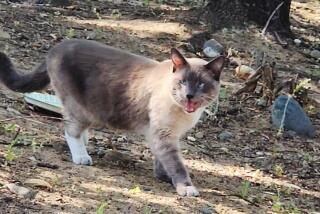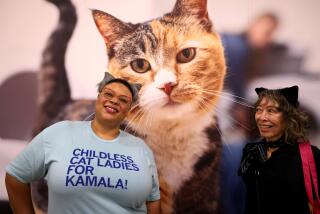They Are the Stars of Comic Strips, Books and Even a Broadway Musical. Nothing Causes Such a Stir as . . . : CATS
RAMONA â This is a fluff piece.
And letâs face it, why shouldnât it be? Cats, for whom the piece is intended, have never had it so good. Theyâre the subject of several star comic strips. Bookstores are littered with books on cats, and condominium complexes--where dogs are as welcome as what they leave behind--have become havens for cats.
Why, âCatsâ even have their own Broadway musical.
In San Diego County, where near-tropical weather is kitty nirvana, felines are as omnipresent as gushing weathermen. Doesnât it figure that in the kind of environment where kitties thrive, there might be a few with serious star appeal?
There are.
Right here in Ramona lives a cat thatâs the âBest in the Nation.â It isnât a nickname--itâs a fact, proven in frenzied competition.
âHit Paradeâ is the prized possession of Leanne Plunkett, 42, proprietor of Nav-E-Way, one of the oldest âcatteriesâ in the county. Plunkett has been breeding cats (mostly Himalayan and Persian) for 12 years, but she has never had a cat like Hit Parade.
She is--holy hairball!--worth a cool $10,000.
âYes,â Plunkett said modestly, âsheâs my best ever. Sheâs a spectacular cat.â
Hit Parade is, however, only the standard that dozens of cat breeders strive for annually. San Diego is one of the strongholds of the Cat Fanciersâ Assn. (CFA), the most recognized of six such registries in the country.
âMan-Madeâ Breed
Plunkett noted that her favorite, the Himalayan breed, actually got its American start in Chula Vista in 1956. Himalayans are a âman-madeâ breed, crossed from Siamese and Persian, and have recently reached a status that caused old Hit Parade to hit the megabucks category.
Plunkett estimated that San Diego County has from 20 to 30 âseriousâ breeders of nearly all types of cats. One is Diana Price of Carlsbad, who, with her husband, Bill, has bred cats for 30 years. Theyâre the owners of The Golden Cat, a breeding referral service. Dying to have a seal-point Siamese? Call The Golden Cat, find out how to get one. Try to have several hundred dollars ready, though. Purebred cats sell between $250 and $350, some as high as $1,500.
Price, 45, says breeding the furry creatures is definitely âan acquired taste,â like appreciating exotic beer or Elizabethan music. Once youâve got it, she said, you canât get rid of it.
Sheâs aware that some cat lovers cringe the first time they see a cattery. They donât understand why many are kept in small cages (usually 4-by-6 feet) and donât run around like other cats. Many breeders choose to live in places like Ramona and Poway to avert animal control provisions that prohibit keeping, say, 42 cats in the city. If cats were allowed to run around in places like Ramona and Poway, coyotes might never go hungry. As breeder Jeanen Monteleone of Poway said, âI once lost a $400 cat to coyotes.â
Some ordinary cat lovers wonder why all the fuss over the looks of so-called âshowâ cats. Whatâs beautiful, they sometimes ask, about a Persian with a flat face, or a Siamese with points (feet, ears and facial markings of a color different from the rest of the body)?
The Cultivated Look
âGlamour cats,â Price said, âare a little like beauty queens. Miss America is usually tall, slender, almost gaunt, with high cheekbones and big eyes. She is probably not the girl who was prom queen in high school, with short hair, lots of curls, plenty of dimples and is as cute as an ever-loving button. No matter how cultivated our cats look, they are still sweet and lovable.â
If cat breeders didnât love their cats, Price said, they couldnât have a cattery. Costs often run in the thousands of dollars--on an average, from $3,000 to $5,000 a year or, with big vet bills, $10,000 a year--and couldnât be tolerated, she said, âif you just didnât adore your animals. We love our cats. And thereâs nothing more fun than watching a litter of kittens play. You can sit on the floor and just roar with laughter at their antics.â
Catteries are often criticized, she said, for contributing to the cat population. But breeders often know in advance where a kitten is going. Sales frequently come before a litter is born, and good homes for purebred, registered cats are, she said, seldom hard to find.
Plunkett checks out all buyers thoroughly in advance. She says itâs hard enough to part with a kitten, especially one with potential, much less fear its having to go to a lousy home. Plunkett also defends the kinds of conditions catteries have to keep.
âMy females live in an outside (enclosed) run,â she said. âLetâs face it, I donât want $10,000 running down the street. My boys (male cats) live in a 4-by-8-foot enclosure, which is really a big size, half the size of a small bedroom in a house. They have a good life. I try, if I can, to keep a girl with the boys--an altered (spayed) female--so they wonât get lonely. I have a 7-by-3-foot maternity cage, so when a momma has kittens, Iâll confine her to that area for several weeks.â
Plunkett got into cat breeding partly for survival. Her Navy husband was deployed for long periods at sea, and she got lonely. She thought breeding kittens might keep her occupied. The desire soon became one of wanting a grand champion, then wanting the best in the nation.
Genetics and Luck
Hit Parade was largely the product of luck. Her father, Rocky Mountain High, was voted the best seal point in the nation in 1982 and has sired a fleet of champions. Hit Paradeâs mother is a solid-color Persian, bred to a father with points. Usually, offspring of such cats come out solid.
Hit Parade was Plunkettâs first and only exception.
Plunkett isnât the only breeder who enjoys playing the genetic game with cats. Monteleone, who runs the Fireworks Cattery in Poway (her husband is a pyrotechnician, hence the name), said genetics is one of the main things keeping her in the business. On a recent afternoon, she was tending more than 45 cats. Several mothers had just had litters.
âYou have to know a lot of medicine, biology and physiology,â she said. âYou have to know how to deliver a kitten if something goes wrong. To produce kittens of the color and type you want, a lot of thinking goes into it. If youâre surprised, youâve done something wrong. And often, you are surprised.â
The most crushing disappointments are, however, the result of illness, something cats seem inflicted with more than most mammals. Maybe it only seems that way, Monteleone said. Theyâre small, frail and helpless, for the most part, and have a way of making owners feel likewise when sickness sets in.
Monteleone has thought often of quitting the cattery, a business sheâs had for five years. The demands are excruciating and expensive. Vacations are a major hassle. But she, like hundreds of breeders, keeps going, yearning for a prized champion.
Her Hit Parade.
âBesides,â she said with a smile, âI have more cats than friends.â
More to Read
The biggest entertainment stories
Get our big stories about Hollywood, film, television, music, arts, culture and more right in your inbox as soon as they publish.
You may occasionally receive promotional content from the Los Angeles Times.










